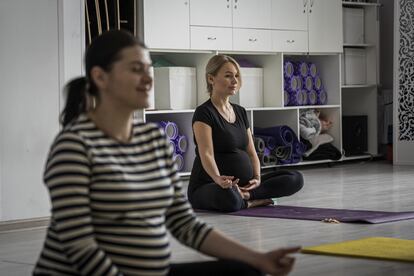How to boost physical activity in expecting moms
Pregnant women are advised to aim for 150 minutes of moderate aerobic exercise weekly, but less than 30% do it

Exercising during pregnancy has many benefits, but unfortunately, not many women do it. Less than 30% of pregnant women worldwide meet physical activity recommendations, while in developed countries, 45% to 55% of those who aren’t pregnant exercise regularly. Physical exercise during pregnancy helps lower the risk of hypertension and gestational diabetes, and helps control body weight. It can also be beneficial in treating medical conditions, like improving glycemic control in pregnant women with diabetes.
But there’s another problem. Less than half of healthcare professionals are familiar with the guidelines for physical activity during pregnancy, and only a third of expecting mothers receive any form of professional advice on the matter. Although official recommendations for exercising during pregnancy exist, it appears that they fail to reach the women who truly need them. In this article, we run through some physical activity recommendations during pregnancy and how healthcare providers can support women to stay active throughout this crucial period.
The Centers for Disease Control and Prevention (CDC) advises pregnant women to aim for 150 minutes of moderate aerobic exercise weekly. Most women can safely exercise during pregnancy, but those with specific health conditions should first consult a doctor. The Get Active Questionnaire for Pregnancy is another tool to address concerns. However, certain medical conditions require avoiding exercise, such as uncontrolled hypertension, restrictive lung disease, multiple pregnancies (three or more), persistent vaginal bleeding, and severe anemia. It’s also recommended to avoid high-risk activities, high-impact or contact injuries, and oxygen-limiting activities at high altitudes. Women who were previously inactive should steer clear of high-intensity activity. On the other hand, women who exceeded activity recommendations before pregnancy should consult a health professional specialized in athletics.
Women often face challenges when it comes to exercise during pregnancy. Concerns about the impact on the fetus, pelvic floor issues, nausea, fatigue and anxiety can make it difficult to stay active or stick to a regular routine. Moreover, lack of time or support at home can further hinder their ability to exercise. It is crucial for health professionals to truly understand the feelings, concerns and conditions of their patients before recommending a generic exercise program. A personalized approach, rather than a one-size-fits-all solution, could be the key.
To provide meaningful guidance, health professionals should focus on their patient’s goals and feelings. Regarding physical exercise, there are four general groups of pregnant women: 1) Those who are already active and want to continue exercising during pregnancy; 2) Those who are active but don’t intend to continue; 3) Those who are not active but want to start; and 4) Those who are not active and don’t intend to start. Each group requires a different approach. For example, Group 1 might require immediate support or assistance, while Group 2 could benefit from a goal-oriented approach. Group 3 may find a motivational discussion helpful, and Group 4 may need more guidance on physical activity.
Pregnant women should consider practical ways to incorporate physical activity into their daily lives. Simple things like climbing stairs or having walking meetings can be beneficial. They should also recognize daily physical activities like housework or running errands as part of their exercise routine. Health professionals may find it difficult to recommend exercise during pregnancy if they don’t have the training, confidence, time and resources. In this case, they can use tools like this infographic created by British physicians that offers easy-to-understand guidelines on physical activity during pregnancy.
Pregnancy is an extraordinary moment in life, offering a unique opportunity to optimize and maintain health. It’s crucial for healthcare professionals to be well-prepared in motivating pregnant women to exercise. These professionals hold the power to reshape the narrative around physical activity during pregnancy, dispelling fear and misinformation, while highlighting the numerous benefits for expecting mothers. When a pregnant woman expresses interest in exercising, healthcare professionals should refer her to physical fitness specialists who can design exercise programs tailored to the needs of healthy individuals and those with specific health conditions.
Sign up for our weekly newsletter to get more English-language news coverage from EL PAÍS USA Edition
Tu suscripción se está usando en otro dispositivo
¿Quieres añadir otro usuario a tu suscripción?
Si continúas leyendo en este dispositivo, no se podrá leer en el otro.
FlechaTu suscripción se está usando en otro dispositivo y solo puedes acceder a EL PAÍS desde un dispositivo a la vez.
Si quieres compartir tu cuenta, cambia tu suscripción a la modalidad Premium, así podrás añadir otro usuario. Cada uno accederá con su propia cuenta de email, lo que os permitirá personalizar vuestra experiencia en EL PAÍS.
¿Tienes una suscripción de empresa? Accede aquí para contratar más cuentas.
En el caso de no saber quién está usando tu cuenta, te recomendamos cambiar tu contraseña aquí.
Si decides continuar compartiendo tu cuenta, este mensaje se mostrará en tu dispositivo y en el de la otra persona que está usando tu cuenta de forma indefinida, afectando a tu experiencia de lectura. Puedes consultar aquí los términos y condiciones de la suscripción digital.
More information
Últimas noticias
Most viewed
- Charles Dubouloz, mountaineering star, retires at 36 with a farewell tour inspired by Walter Bonatti
- CBS in crisis after pulling a report on Trump’s deportations to El Salvador (which later leaked online)
- The Florida Keys tourist paradise is besieged by immigration agents: ‘We’ve never seen anything like this’
- December Social Security and SSI payments: Dates, double checks and the 2026 COLA increase
- Chevy Chase, the beloved comedian who was a monster off camera: ‘Not everyone hated him, just the people who’ve worked with him’










































